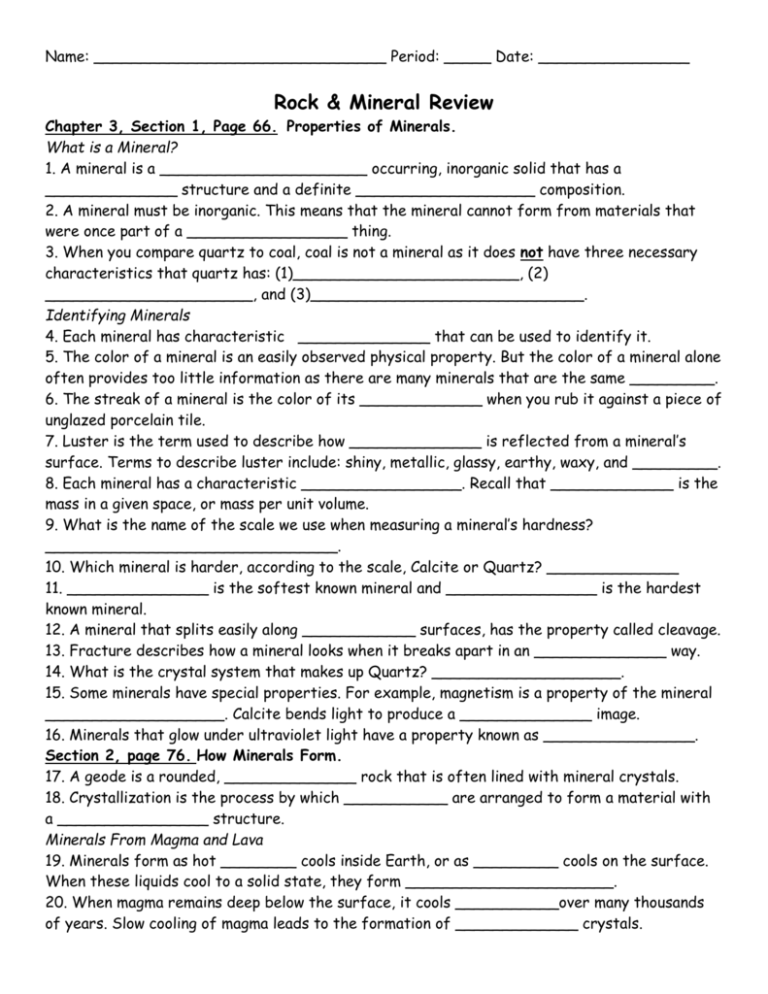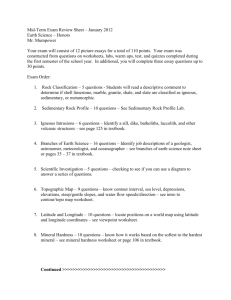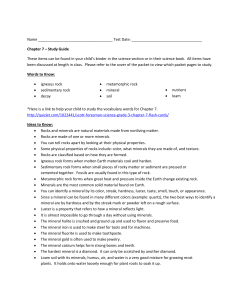Name: Period: _____ Date
advertisement

Name: _______________________________ Period: _____ Date: ________________ Rock & Mineral Review Chapter 3, Section 1, Page 66. Properties of Minerals. What is a Mineral? 1. A mineral is a ______________________ occurring, inorganic solid that has a ______________ structure and a definite ___________________ composition. 2. A mineral must be inorganic. This means that the mineral cannot form from materials that were once part of a _________________ thing. 3. When you compare quartz to coal, coal is not a mineral as it does not have three necessary characteristics that quartz has: (1)________________________, (2) ______________________, and (3)_____________________________. Identifying Minerals 4. Each mineral has characteristic ______________ that can be used to identify it. 5. The color of a mineral is an easily observed physical property. But the color of a mineral alone often provides too little information as there are many minerals that are the same _________. 6. The streak of a mineral is the color of its _____________ when you rub it against a piece of unglazed porcelain tile. 7. Luster is the term used to describe how ______________ is reflected from a mineral’s surface. Terms to describe luster include: shiny, metallic, glassy, earthy, waxy, and _________. 8. Each mineral has a characteristic _________________. Recall that _____________ is the mass in a given space, or mass per unit volume. 9. What is the name of the scale we use when measuring a mineral’s hardness? _______________________________. 10. Which mineral is harder, according to the scale, Calcite or Quartz? ______________ 11. _______________ is the softest known mineral and ________________ is the hardest known mineral. 12. A mineral that splits easily along ____________ surfaces, has the property called cleavage. 13. Fracture describes how a mineral looks when it breaks apart in an ______________ way. 14. What is the crystal system that makes up Quartz? ____________________. 15. Some minerals have special properties. For example, magnetism is a property of the mineral ___________________. Calcite bends light to produce a ______________ image. 16. Minerals that glow under ultraviolet light have a property known as ________________. Section 2, page 76. How Minerals Form. 17. A geode is a rounded, ______________ rock that is often lined with mineral crystals. 18. Crystallization is the process by which ___________ are arranged to form a material with a ________________ structure. Minerals From Magma and Lava 19. Minerals form as hot ________ cools inside Earth, or as _________ cools on the surface. When these liquids cool to a solid state, they form ______________________. 20. When magma remains deep below the surface, it cools ___________over many thousands of years. Slow cooling of magma leads to the formation of _____________ crystals. 21. Magma closer to the surface cools much ___________than magma that hardens deep below ground. With more rapid cooling, there is no time to form large crystals. Instead, ____________ crystals form. Minerals From Solutions 22. Sometimes the elements and compounds that form minerals can be dissolved in water to form a ________________. 23. When elements and compounds that are dissolved in water leave a solution, ____________________ occurs. 24. Huge _________________ crystals were discovered in a cave in ________________. 25. Using the diagram on pages 78 and 79, fill in the missing information: Mineral Name Where does it form? How does it form? Gypsum On the surface In hot water (close to magma) magma cools deep beneath the surface. Chapter 4, Section 1, Page 95: Classifying Rocks Mineral Composition and Color 26. Rocks are made of mixtures of ____________________ and other materials. 27. A rock’s color provides clues to the rock’s mineral composition. For example ____________ is generally light-colored rock that has high ________________ content. Basalt is a darkcolored rock that is low in __________________. 28. What minerals are in Granite? (Figure 2) 1. _________________________________, 2.______________________________, 3.______________________________ and 4. ________________________________. Texture (page 96) 29. As with minerals, color alone does not provide enough information to identify a rock. But a rock’s texture is very useful in ______________________________ a rock. 30. Most rocks are made up of particles of minerals or other rocks, which geologists call _______________________. Grains give the rock its texture. 31. ( Figure 4) Fill in the table below to reflect the characteristics of grains. Name of rock Grain Size Fine Grain Diorite No visible grain Name of Rock Name of Rock Grain Shape Rounded Grain Jagged Grain Grain Pattern Nonbanded (Non-foliated) Banded (Foliation) How Rocks Form (page 97) 32. Geologists classify rocks into three major groups: 1. _______________________________ 2. _______________________________ 3. _______________________________ 33. Igneous rock forms from ________________________________________________ 34. Sedimentary rock forms when ___________________________________________ ______________________________________________________________________ 35. Metamorphic rock forms when _____________________________________________ _______________________________________________________________________ Chapter 4, Section 2: (page 98) 36. Igneous rocks are classified according to their ____________________________, texture and mineral composition. 37. Extrusive rock is igneous rock formed from ________________________ that erupted onto Earth’s ______________________. 38. Igneous rock that formed when magma hardened beneath Earth’s surface is called _______________________ rock. 39. Rapidly cooling lava forms ________________-___________________ igneous rocks with small crystals. Slowly cooling magma forms ________________-________________ igneous rocks with large crystals. Chapter 4, Section 3: (page 102) 40. Most sedimentary rocks are formed through a series of processes: erosion, ______________, compaction and _____________________________. 41. In erosion, running water, wind, or ice loosen and _____________ away fragments of rock. 42. Deposition is the process by which _____________________ settles out of the water or wind carrying it. 43. Compaction is the process that _____________________ sediments together. 44. Cementation is the process in which dissolved minerals crystallize and ________________ particles of sediment together. Chapter 4, Section 5: (page 110) 45. Heat and ___________ deep beneath Earth’s surface can __________________any rock into metamorphic rock. 46. Metamorphic rocks that have their grains arranged in parallel layers or bands are said to be ______________________. 47. Some metamorphic rocks are _________-___________________. The mineral grains in these rocks are arranged ________________________. (Figure 17) 48. Granite (igneous) forms ________________ metamorphic. Sandstone (sedimentary) forms ________________metamorphic. Shale (sedimentary) forms ___________________metamorphic. Chapter 4, Section 6: The Rock Cycle 49. Forces deep inside Earth and at the surface produce a slow cycle that ________________, destroys, and __________________ rocks in the crust. (Figure 19) 50. Igneous rock turns into sediment through _______________________________. 51. Volcanic activity produces ______________________ rock. 52. Sedimentary rock forms metamorphic rock through _______________________ and ____________________________. 53. Use these terms to fill in the blanks below: Igneous rock, sedimentary rock, metamorphic rock, magma or lava, sediment. Cooling & Hardening The Rock Cycle






